Advancements in Noninvasive Glucose Monitoring Technologies
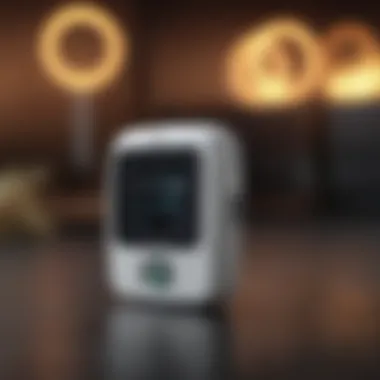

Intro
The landscape of glucose monitoring is undergoing a significant transformation, driven by the pursuit of noninvasive techniques. These advancements hold promise not only for individuals living with diabetes but also for the broader healthcare community. Traditionally, glucose monitoring has relied heavily on invasive methods, often involving regular finger-pricking that can be uncomfortable and inconvenient. Today, however, innovative technologies are emerging that aim to replace these methods with more user-friendly alternatives.
As diabetes prevalence continues to rise globally, it is crucial to explore how noninvasive glucose monitoring can improve patient outcomes and offer an easier way to manage this chronic condition. The implications of these technologies extend beyond individual patient preferences; they have the potential to reshape the entire management approach of diabetes care.
This exploration is vital for students, researchers, educators, and professionals alike, as it sheds light on the technologies that are pushing the boundaries of healthcare and providing insights into their future applications.
Key Findings
Summary of the Main Results
Recent studies focusing on noninvasive glucose monitoring have revealed several significant findings:
- Reliability: New optical sensors and bio-sensors have shown promising results in their ability to provide accurate readings without skin penetration.
- User Acceptance: Many participants in trials have reported a preference for noninvasive methods, highlighting comfort and convenience as major factors.
- Integration with Technology: The rise of wearable technology has allowed for better data analysis and integration into daily life, using smartphones and other devices to assist in glucose tracking.
These findings indicate not only advances in technology but also a shift in user experience, which is crucial for sustained health management.
Significance of Findings Within the Scientific Community
The significance of these findings cannot be overlooked. Researchers argue that noninvasive methods can potentially enhance diabetes self-management and improve patient compliance significantly. The ability to monitor glucose levels conveniently may lead to more proactive health behaviors and potentially reduce complications associated with poor glucose control.
"The transition to noninvasive monitoring is not just a technological upgrade; it has the potential to redefine diabetes management altogether."
Implications of the Research
Applications of Findings in Real-World Scenarios
The implications of these research findings extend well beyond laboratory trials. Some possible applications include:
- Telehealth Integration: Noninvasive monitoring can facilitate remote monitoring of glucose levels, improving access for patients in rural areas.
- Enhanced Compatibility: These technologies can be integrated with health apps, allowing for real-time feedback to users, which can increase engagement and adherence.
- Personalized Medicine: Custom algorithms can tailor health advice based on real-time data, moving towards a more personalized approach in diabetes management.
Potential Impact on Future Research Directions
The direction of future research is likely to be influenced significantly by these preliminary findings. Areas to explore may include:
- Long-term Efficacy: There is a need for long-term studies to assess the efficacy and safety of these noninvasive devices over extended periods.
- Wider Population Studies: More diverse study populations can help understand how these technologies perform across different demographics and health conditions.
- Technology Development: Continuous development of materials and methods will be required to enhance accuracy and reliability in adverse conditions.
Intro to Noninvasive Glucose Monitoring
Understanding noninvasive glucose monitoring is crucial for several reasons. For starters, this technology stands as a beacon of hope for many people living with diabetes, making daily life more manageable without the discomfort of traditional invasive methods. Noninvasive techniques limit the need for finger pricks, which can deter patients from proper monitoring. Glucose monitoring becomes smoother, leading to better adherence to management practices.
Definition and Importance
Noninvasive glucose monitoring refers to methods of measuring glucose levels without the need for blood samples. Instead of pricking the skin, these methods leverage various technologies to capture and analyze glucose levels through different means. This technology offers considerable importance as diabetes continues to be a global health challenge. The ability to monitor glucose levels effectively can directly impact a patient's health, help in decision-making concerning insulin dose adjustments, and improve overall quality of life.
Patients benefit greatly from removing the painful aspects of monitoring. They can opt for continuous glucose monitors that can be worn on the skin instead of traditional methods that require blood samples. This means a smoother experience and something that can be integral in keeping their glucose levels within an acceptable range.
Historical Context
The evolution of glucose monitoring has roots in mechanical devices of the late 19th century. Back then, methods were rudimentary, often leading to inaccuracies. The early 20th century saw the introduction of blood-based measurements, which became the standard throughout the years, but they came with a cost – both financial and emotional.
As the 21st century approached, researchers began exploring alternatives. The groundwork laid by scientists led to innovations such as the first commercial continuous glucose monitors in the early 2000s. These developments have been the stepping stones towards the noninvasive technologies we see today. Innovations like near-infrared spectroscopy and other optical techniques have moved the field forward considerably. The more recent advancements show promise for even greater ease and accuracy, leading us into a fascinating period ripe with potential for improved diabetes management.
"The evolution from invasive to noninvasive methods in glucose monitoring not only marks a technological advancement but reflects a deeper understanding of patient needs and lifestyle."
By piecing together this historical fabric, it's evident that noninvasive glucose monitoring is not just a technological shift; it represents a paradigm change in how we approach diabetes care.
Mechanisms of Glucose Monitoring
Glucose monitoring is central to managing diabetes, offering critical insights into patients' health. Various mechanisms have emerged, revolutionizing the way individuals can track their glucose levels without invasive procedures. Understanding mechanisms of glucose monitoring is crucial; they not only improve patient comfort but also enhance the reliability of data, aiding in more effective treatment plans.
Optical Methods
Optical methods are one of the forefront techniques used in noninvasive glucose monitoring. These methods primarily utilize light to determine glucose levels in the body. The ability to maintain a consistent level of accuracy while being noninvasive makes optical methods appealing. They are often characterized by their non-contact nature and quick data acquisition, further contributing to their benefit for users.
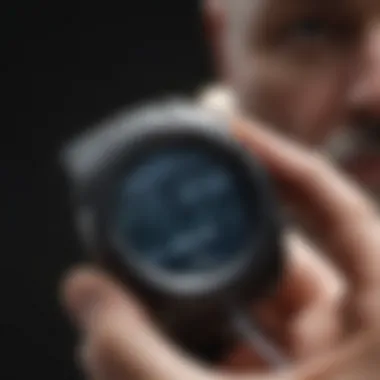
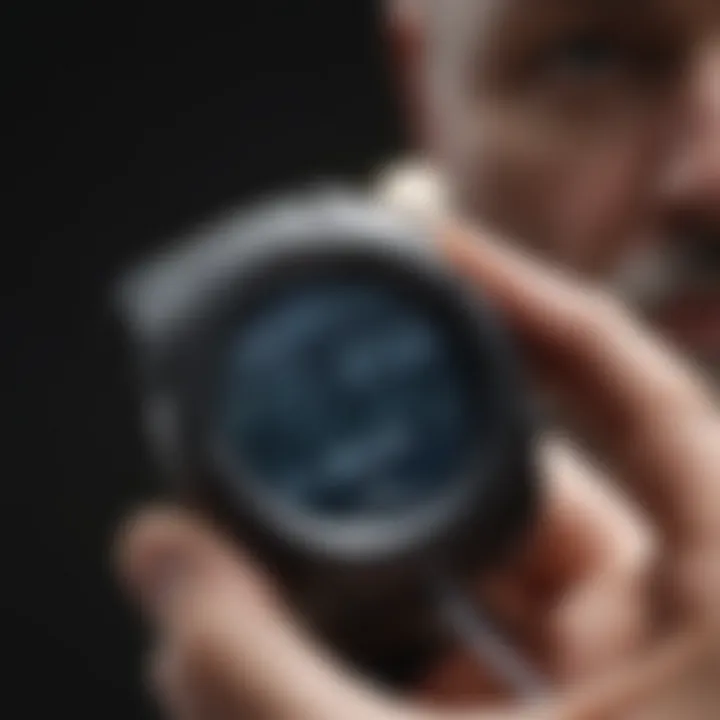
Near-Infrared Spectroscopy
Near-Infrared Spectroscopy (NIRS) involves shining near-infrared light on the skin and measuring how much light is absorbed or reflected by glucose molecules. This technique has gained traction because it can provide results without the need for skin penetration. The key characteristic of NIRS lies in its ability to get readings from a variety of sites on the body, making it adaptable.
A unique aspect of NIRS is its capability to analyze large areas, allowing for potentially accurate readings over a wider field. While it enjoys many advantages, its primary disadvantage includes susceptibility to interference from skin pigmentation and other biological factors, which can sometimes lead to less reliable results.
Raman Spectroscopy
Raman Spectroscopy operates on the principle of inelastic scattering of light. When light interacts with glucose, it conveys unique vibrations that can be detected and analyzed. This method's key characteristic is its ability to provide molecular-specific information, which can be extremely advantageous in clinical settings.
Raman Spectroscopy is particularly notable for its minimal sample preparation and ability to yield results from various tissues. Yet, it is also not without its drawbacks; for example, producing a Raman signal from biofluids can be challenging due to the low efficiency of the Raman scattering process.
Electromagnetic Techniques
Electromagnetic techniques utilize electromagnetic fields to ascertain glucose levels within the body. This approach offers a distinct advantage as it often requires little to no user intervention, making the process smooth for patients.
Microwave Techniques
Microwave Techniques employ microwave radiation to measure glucose concentrations in body fluids. Characterized by its ability to provide real-time feedback, these methods become significant in the realm of glucose monitoring.
A unique feature of microwave techniques is their potential to monitor changes in glucose levels continuously, equipping patients with timely data that informs safety and health decisions. However, these techniques face challenges as well, notably in accuracy and variation based on hydration levels in the monitored individual.
Radiofrequency Technology
Radiofrequency Technology operates similarly to microwave methods but generally employs lower frequencies. It emerges as a beneficial option given its non-invasive nature and relatively straightforward implementation.
A significant advantage of radiofrequency technology is its capacity to penetrate deeper tissues, which can yield more stable readings. Conversely, challenges may arise in terms of the equipment's size and the need for device calibration, which can complicate user engagement.
Transdermal Sensors
Transdermal sensors present an exciting avenue in noninvasive glucose monitoring by focusing on harnessing the skin's properties. This segment of technology offers insights that are critical for continuous glucose monitoring.
Iontophoresis
Iontophoresis is a technique that employs electrical currents to facilitate the transport of glucose molecules to the skin surface, where they can then be measured. The key characteristic of this method is its ability to deliver near-continuous data with minimal discomfort.
A notable advantage is that it allows for measurements without the need for finger pricks. However, the technique's backlash encompasses potential skin irritation and requires precise calibrations, posing questions about patient adherence.
Microneedle Arrays
Microneedle arrays consist of tiny needles that create microchannels in the skin, allowing for the efficient extraction of interstitial fluid containing glucose. The distinguishing feature of microneedle arrays is their minimally invasive nature combined with their effectiveness in glucose sampling.
The apparent advantage here is their ability to provide accurate results comparable to traditional methods, yet they face their own challenges such as sterility concerns and the demand for regular replacement or maintenance.
In summary, the mechanisms behind glucose monitoring are pivotal for enhancing diabetic care, each offering unique characteristics which can be beneficial yet also raise specific challenges. Understanding these mechanisms is essential as it paves the way for developing smarter, more efficient glucose monitoring systems.
Advantages of Noninvasive Monitoring
Noninvasive glucose monitoring technologies offer a critical advantage in the management of diabetes, as they seek to improve patient experience and optimize clinical outcomes. The significance of these advantages can’t be underestimated; they aren't just enhancements, but rather a rethinking of how glucose is monitored and managed. This shift embodies three fundamental strengths: patient comfort and compliance, cost-effectiveness, and real-time monitoring benefits. Each of these elements plays a key role in advancing diabetic care into a more proactive and patient-centered domain.
Patient Comfort and Compliance
When considering medical devices, comfort is paramount, especially for patients who have to engage with these technologies daily. Noninvasive glucose monitors eliminate the frequent pricking of fingers, which can cause discomfort and, over time, might lead to reduced adherence to monitoring regimens. The transition from invasive to noninvasive monitoring not only enhances comfort but also naturally increases compliance among patients. Furthermore, devices that utilize less intrusive methods – such as optical detection or transdermal sensors – tend to be perceived as less burdensome, making it easier for individuals to integrate monitoring into their routines. For instance, a user-friendly smart wearable that seamlessly tracks glucose levels can really motivate individuals to keep a closer eye on their health without feeling overwhelmed by the process.
Cost-Effectiveness
Cost plays a pivotal role in healthcare decision-making. Traditional glucose monitoring methods, which rely heavily on strips and lancets, can accumulate significant expenses over time. Noninvasive technologies rarely involve ongoing costs for needles or other consumables, making them economically appealing for both patients and healthcare systems. Moreover, they have the potential to reduce complications tied to poorly managed glucose levels, which can be financially burdensome. By facilitating better glucose control through less friction in monitoring, noninvasive approaches can ultimately lead to lower healthcare costs as they prevent hospitalizations and other related medical expenses.
"Effective glucose management can save both lives and substantially reduce the healthcare burden on systems worldwide."
Real-Time Monitoring Benefits
One of the standout benefits of noninvasive glucose monitoring is the ability to provide real-time data. This immediacy offers a significant edge, allowing patients to make timely decisions regarding their diet, activity level, and insulin administration. For example, if a glucose level spiking is detected, a patient can respond instantly, perhaps opting for a quick dose of insulin or a sugar-lowering snack. The dynamic feedback loop created through real-time monitoring enables tailored, responsive diabetes management. Furthermore, the integration of smart technologies, such as app notifications, ensures patients have reminders and insights at their fingertips, which can augment their sense of control over their health.
Noninvasive glucose monitoring technologies facilitate strikes at the heart of diabetes management: patient comfort, economic sense, and immediate feedback. The growing reliance on these advantages speaks volumes about the future of monitoring in healthcare, ultimately charting a healthier course for those living with diabetes.
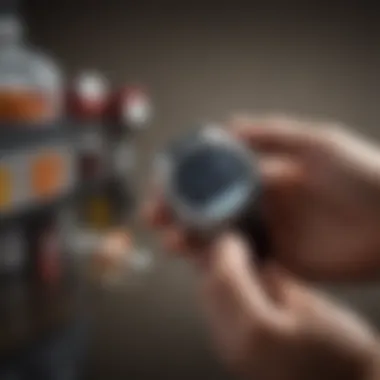
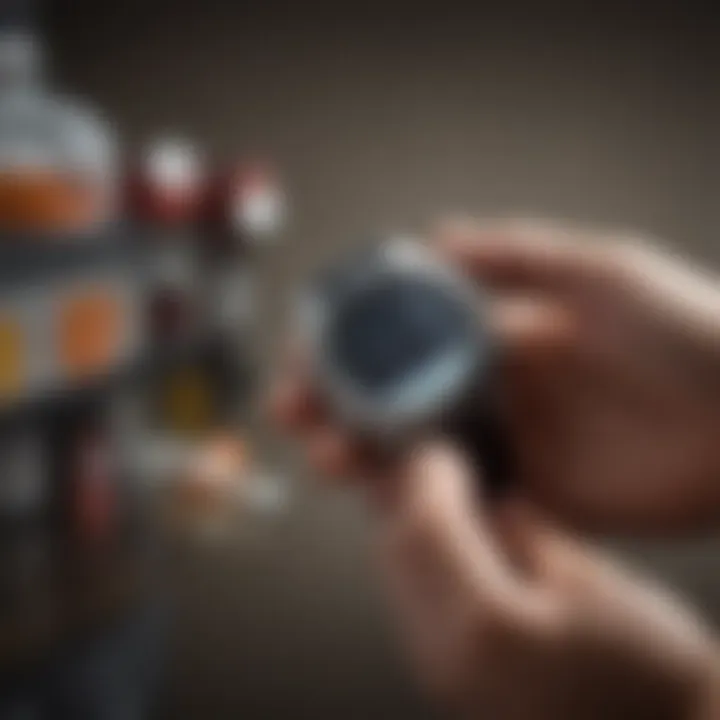
Current Technologies in Use
The significance of current technologies in noninvasive glucose monitoring cannot be overstated. As advancements unfurl in this field, they directly impact diabetic care and management. These technologies not only bridge the gap between traditional methods and patient needs but also present an opportunity for greater accessibility and patient empowerment. People managing diabetes can gain strategic insights into their glucose levels without the discomfort of needles, enhancing their overall quality of life.
Commercially Available Devices
Continuous Glucose Monitors (CGMs)
Continuous Glucose Monitors, or CGMs, revolutionize the way glucose levels are tracked. These devices provide real-time glucose readings, enabling patients to respond promptly to fluctuations. A special characteristic of CGMs is their ability to alert users when glucose levels move beyond set thresholds. For many, this has become a vital tool in their daily management routine.
One notable feature of CGMs is their integration with smartphone technology. Devices like the Dexcom G6 allow users to view their glucose data via a companion app, directly on their phones. This ease of access ensures patients stay informed on their glucose levels throughout the day.
However, despite the advantages, one disadvantage is the cost. Many insurances may not fully cover these devices, making them less accessible to some patients. In this way, while CGMs offer substantial benefits in monitoring and management, barriers do still exist.
Smart Wearables
Smart wearables have emerged as versatile tools in noninvasive glucose monitoring. These devices incorporate cutting-edge sensors that can track glucose levels as well as provide additional fitness data. A key aspect of smart wearables is their multifunctionality, often combining glucose monitoring with health metrics such as heart rate and activity levels. This can help patients maintain not just their glucose levels but also their overall health.
Devices like the Abbott FreeStyle Libre are widely popular among users. One of their unique features is a small sensor that sticks to the skin and provides real-time data every minute. This capability allows broader insights into daily glucose trends, which can lead to better treatment decisions.
While the potential of smart wearables is promising, there's also a learning curve associated with them. Users may find it challenging to interpret complex data accurately without guidance.
Emerging Innovations
Innovations continue to surface in the realm of glucose monitoring, with significant implications for everyday use.
Smartphone Integration
The integration of smartphone technology into glucose monitoring systems is a game changer. Patients can manage their glucose levels seamlessly through apps that provide detailed analysis and allow for tracking over time. The ability to share information with healthcare providers in real-time is another key feature.
A distinctive characteristic of this integration is the user-friendly interface, which can make managing diabetes less intimidating. Many find the visual format of data easier to understand compared to traditional methods. However, not all applications provide reliable data analysis yet, leading to potential misinformation about glucose levels if users are not careful.
AI and Machine Learning Applications
The application of AI and machine learning in glucose monitoring represents a frontier brimming with potential. Algorithms can analyze vast amounts of data to offer personalized feedback and insights.
The significant characteristic of these applications is their capability to predict glucose trends based on historical data. This means that individuals may receive alerts before their glucose levels drop or rise to dangerous levels, improving timely intervention.
Yet, reliance on AI comes with reservations. The importance of clinical oversight cannot be overstated, as algorithmic inaccuracies may lead to misguided actions. Thus, while promising, this aspect of technology needs careful implementation and validation to ensure patient safety.
The landscape of glucose monitoring is witnessing rapid advancement, but challenges remain in the journey toward optimal patient management.
Challenges and Limitations
The journey to a fully functional noninvasive glucose monitoring system is paved with both promise and obstacles. The challenges and limitations of these technologies warrant serious attention, as they directly impact the systems' efficacy and general acceptance among users and clinicians. Addressing these elements is not just crucial for developers, but it also plays a significant role in the patients' lives who rely on accurate glucose readings for their daily health management.
Accuracy and Reliability Issues
When it comes to monitoring glucose levels without piercing the skin, precision is paramount. Noninvasive methods, while innovative, often grapple with accuracy that can be significantly influenced by external factors. Variations in a person's skin type, hydration levels, and even temperature can skew the readings.
For instance, one study showed that skin pigmentation might alter the absorption of light in optical methods, leading to misreadings for certain demographics. Reliability is a cornerstone feature of any glucose monitoring device, as inconsistent results can mislead users, pushing them either into unwarranted panic or a false sense of security.
“In medicine, inaccurate data isn’t just an inconvenience; it can lead to catastrophes.”
Ensuring that technology is free from such reliability issues is essential to gain trust and have lasting applications in diabetes care.
Regulatory and Approval Hurdles
The road to market isn't just about innovation. Noninvasive glucose monitoring technologies must also travel through a complex maze of regulatory approvals before they can reach the consumer’s hands. Governments usually enact stringent guidelines to ensure that medical devices meet specific standards of safety and effectiveness.
This can involve extensive clinical trials, data gathering, and analysis that can take several years. For brands looking to roll out a new monitoring device, this process can become a lengthy affair, affecting time-to-market and overall development costs. The approval process often varies between regions, adding another layer of complexity for manufacturers.
This makes it imperative for companies to not only perfect their technologies but also to be prepared for the excruciatingly slow approval timelines that can stall potentially life-saving devices.
Market Acceptance and Awareness


Adopting new technology is always a balancing act. Even when a noninvasive glucose monitoring device proves to be reliable and accurate, it still must overcome a widespread skepticism. Patients often remain deeply anchored in their familiar routines, particularly concerning their health. The traditional needle-prick method, although uncomfortable, feels proven and understandable, thus creating a barrier for accepting newer systems.
Furthermore, education on how the new technologies operate and the potential benefits they offer is essential. Patients need to understand how to integrate these systems into their daily lives. Ongoing education and outreach are crucial. The general populace must be made aware of both the transformative potential of these technologies and their actual capabilities.
In summary, tackling the accuracy and reliability issues, navigating through regulatory and approval hurdles, and boosting market acceptance and awareness are pivotal for the success of noninvasive glucose monitoring technologies. Understanding these challenges helps reshape strategies in advancing patient-centric solutions.
Future Directions in Research
As we look to the horizon of noninvasive glucose monitoring, it becomes clear that the domain is not just evolving but also expanding in ways previously thought cumbersome. This section will delve into significant advancements and integrations poised to shape future research. Key areas include Advancements in Material Science and Integration with Personal Health Monitoring. These aspects are vital, for they hold the potential to enhance the effectiveness, accessibility, and user-friendliness of glucose monitoring technologies.
Advancements in Material Science
Material science plays a pivotal role in developing more effective noninvasive monitoring mechanisms. The quest for better materials is like hunting for gold; the right components can dramatically influence performance and cost. Researchers are exploring biocompatible polymers, innovative nanomaterials, and conductive materials that can improve sensor sensitivity and reduce noise. For instance, by incorporating nanostructured materials, we can achieve a deeper interaction with glucose molecules without the invasiveness of traditional methods.
- Nanoparticles can enhance signal amplifications and improve the detection rates of glucose in biological samples.
- Flexible sensors made from organic materials can facilitate skin contact, making monitoring more pleasant for the user.
- The use of smart coatings on sensors can help maintain their accuracy over time, even in varying environmental conditions.
A leap in material science can thus lead to devices that are not just more accurate, but also more durable, making them suitable for daily wear. While challenges remain—like confirming the long-term stability of these materials under physiological conditions—ongoing research promises innovative solutions.
Integration with Personal Health Monitoring
The integration of noninvasive glucose monitors with personal health systems is another promising avenue of research. This integration expands the scope of monitoring from just glucose levels to a more holistic view of health. Imagine an ecosystem where glucose readings, physical activity, sleep patterns, and dietary habits all feed into a singular health management system.
Such integration would open doors to personalized health insights:
- Data Synchronization: Noninvasive glucose meters can seamlessly sync with smartphones and health apps, allowing users to visualize trends and receive alerts when levels are out of bounds.
- AI Algorithms: The incorporation of artificial intelligence can further tailor suggestions based on individual health data. For instance, adjusting dietary recommendations based on a person’s unique glycemic response.
- Community Engagement: Platforms could serve as forums for sharing experiences. This could lead to better support networks filled with practical tips and shared stories, helping others navigate diabetes management.
The potential for a truly integrated health system is both exciting and formidable. The readiness and adaptability of users, technological advancements, and regulatory considerations must all align for a smooth implementation. But with the current wave of digital health technologies, the future seems within reach.
In summary, the future directions in noninvasive glucose monitoring hinge significantly on material advancements and seamless integrations with health ecosystems. Pursuing these avenues not only enhances the user experience but also promises better management of diabetes and overall health.
Implications for Diabetes Management
The evolution of noninvasive glucose monitoring technologies has significant implications for diabetes management. As healthcare professionals and patients seek to improve the quality of life for those living with diabetes, understanding how these technologies fit into personalized treatment plans and affect clinical outcomes is crucial. This section will delve deeper into these two essential facets that highlight the transformative nature of modern glucose monitoring approaches.
Personalized Treatment Plans
One of the most exciting aspects of noninvasive glucose monitoring is its potential to tailor diabetes management to the individual’s unique needs. By providing real-time, accurate glucose readings without the need for finger pricks, these devices can offer a more nuanced view of a patient’s glucose patterns throughout the day.
- Data-Driven Decisions: Continuous glucose data allows healthcare providers to make informed adjustments to medications, diet, and exercise regimens based on actual glucose levels. This variability data can lead to better HbA1c scores, which ultimately improves overall health.
- Convenience and Adherence: Patients often show greater compliance when they use devices that prioritize comfort and ease. Noninvasive methods can reduce the mental and physical burden associated with traditional monitoring.
- Integration with Lifestyle: These advanced monitoring systems can seamlessly integrate with smartphones and wearable technology, providing alerts and insights that help individuals make on-the-fly decisions about their health. This fusion of technology and medicine means that treatment plans can evolve as quickly as the data dictates.
By focusing on personalized treatment, noninvasive glucose monitoring is shifting diabetes management from a one-size-fits-all approach to something much more nuanced and individualized.
Impact on Clinical Outcomes
The implications for clinical outcomes with the widespread adoption of noninvasive glucose monitoring are profound. Enhanced monitoring technology can improve not just individual health, but also population health trends.
- Reduction in Complications: Consistent, accurate monitoring helps prevent the extremes of hyperglycemia and hypoglycemia, two significant concerns for diabetes patients. With fewer episodes of dangerously high or low blood sugar, patients can potentially avert complications such as neuropathy, retinopathy, and cardiovascular diseases.
- Empowered Patients: With tools that foster a deeper understanding of their condition, patients often become more engaged in their own care. This empowerment leads to improved self-management and can result in better health outcomes.
- Continuity of Care: Noninvasive monitoring can provide a continuous stream of data that can be invaluable during medical consultations, allowing healthcare providers to observe trends over time and make informed decisions regarding treatment adjustments. This continuity allows for more proactive care rather than reactive measures.
"The potential of these new monitoring technologies is not only in improving individual glucose levels but in reshaping our understanding of diabetes management at a systemic level."
In sum, the ability to monitor glucose levels without invasive procedures offers a significant leap forward in diabetes care. The development of more personalized treatment plans and the enhancement of clinical outcomes not only benefits patients but also marks a shift in the paradigm of managing diabetes more effectively. As these technologies become embedded into daily life, they promise to change the conversation around diabetes management entirely.
Finale
The advent of noninvasive glucose monitoring presents a pivotal shift in diabetes management and patient care. As outlined through the different sections of this article, the importance of these technologies extends beyond mere convenience; they represent a fundamental change in how individuals can track and manage their health. This conclusion synthesizes the key findings, underscores the significant implications, and emphasizes the need for ongoing research in this field.
Summary of Findings
The exploration of noninvasive glucose monitoring technologies underscores several critical aspects:
- Diverse Technologies: A range of methods, including optical techniques and transdermal sensors, showcase their growing applicability in real-life scenarios, revealing a multifaceted landscape of options.
- Patient-Centric Approaches: Emphasis on comfort, the accuracy of results, and cost-effectiveness highlights the potential for better patient engagement and adherence in managing diabetes. The use of smart wearables further integrates technology into everyday routines, promoting a proactive approach to health.
- Clinical Implications: The insights gleaned from device performance and data accuracy illuminate the profound impact these innovations can have on clinical outcomes. Personalized treatment plans can be developed based on real-time data, allowing for more tailored and effective interventions.
This synthesis paints a hopeful picture for those managing diabetes, suggesting that the future of glucose monitoring is not only about better technology but a holistic improvement in patient health management.
Call for Continued Research
While enthusiasm surrounding noninvasive glucose monitoring is palpable, it is important to be vigilant about the barriers that still exist. Several areas require focused research efforts, including:
- Accuracy Improvement: Ongoing work is needed to refine the precision of these technologies, overcoming the hurdles that cause discrepancies in glucose readings. This will help ensure that noninvasive methods become reliable alternatives to traditional fingersticks.
- Regulatory Frameworks: As technology advances, clearer guidelines from regulatory bodies are essential to bring these devices to market efficiently. Developing streamlined processes can enhance safety while encouraging innovation.
- Greater Awareness: Educating both healthcare providers and patients about the effectiveness and availability of noninvasive glucose monitoring options is critical. A well-informed audience can lead to more widespread adoption.
In summary, the journey of noninvasive glucose monitoring is just beginning. Continued interdisciplinary research and collaboration among scientists, engineers, and medical professionals will be vital to harnessing the full potential of these technologies. Only through sustained effort can we hope to realize the dream of an accessible, convenient, and effective way to manage diabetes, ultimately improving the quality of life for millions.







